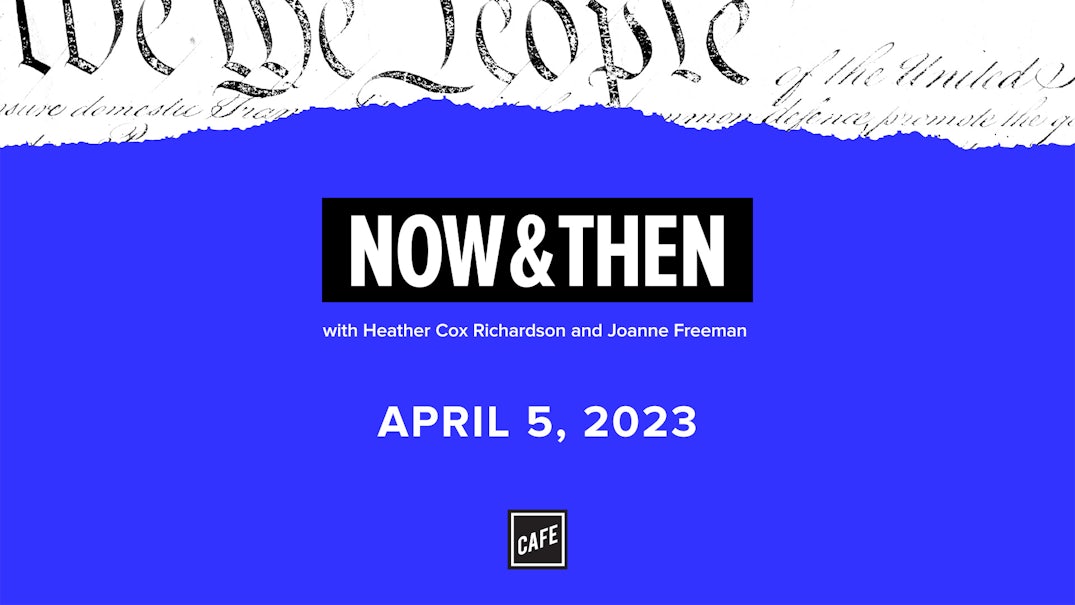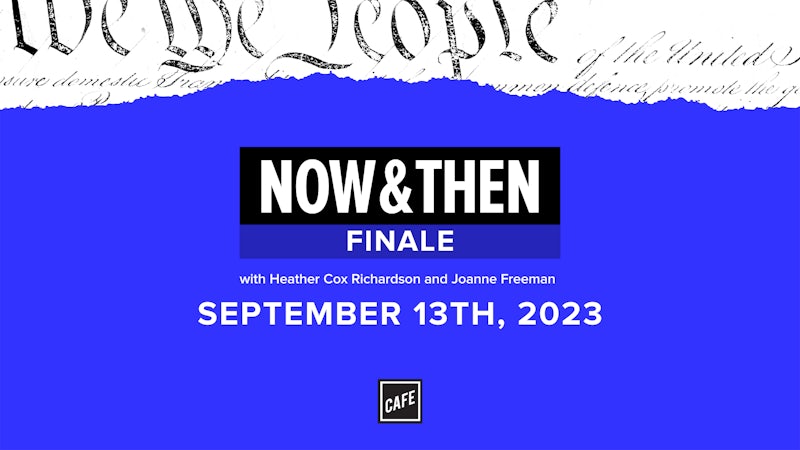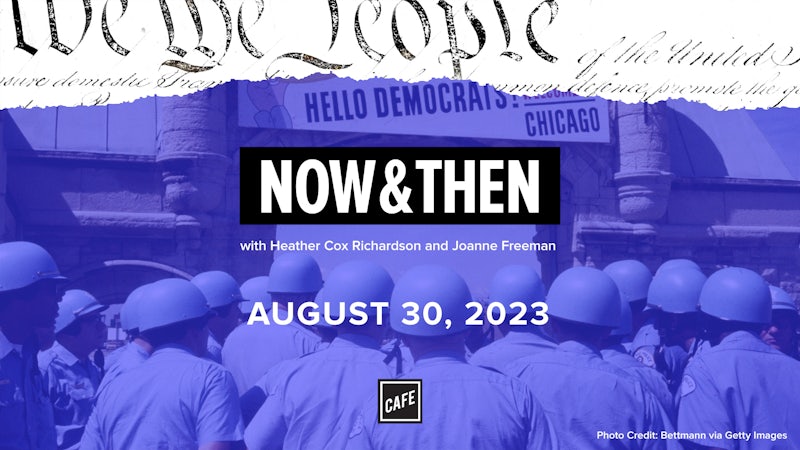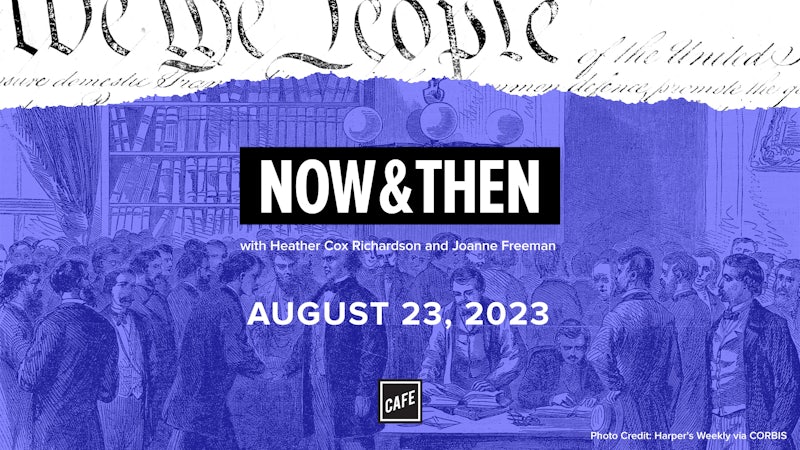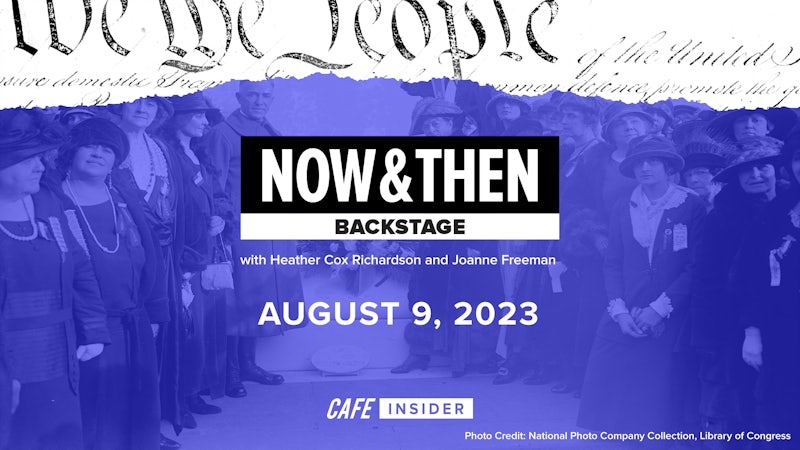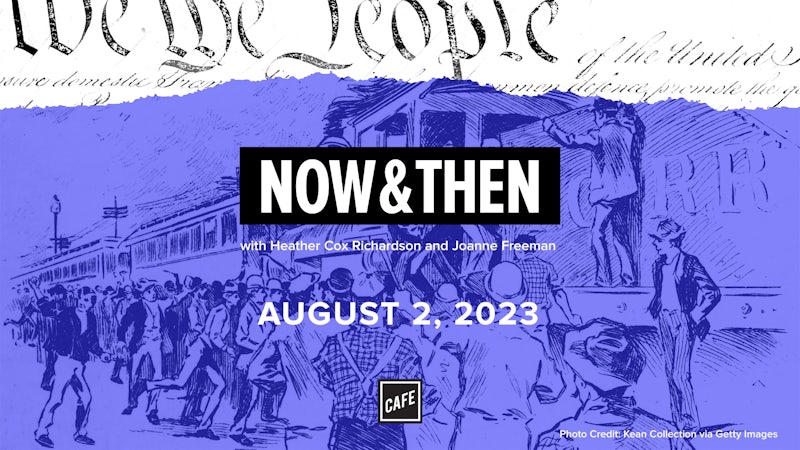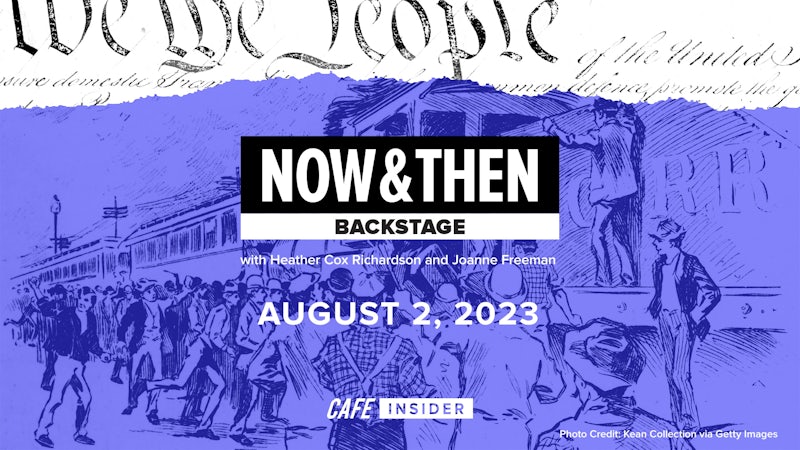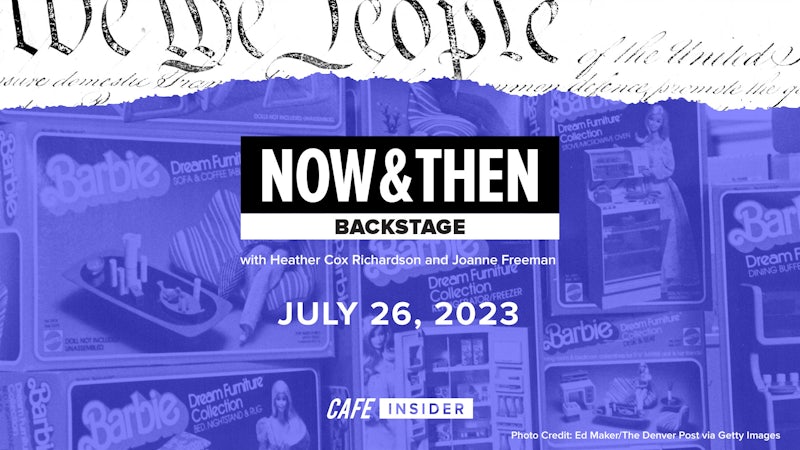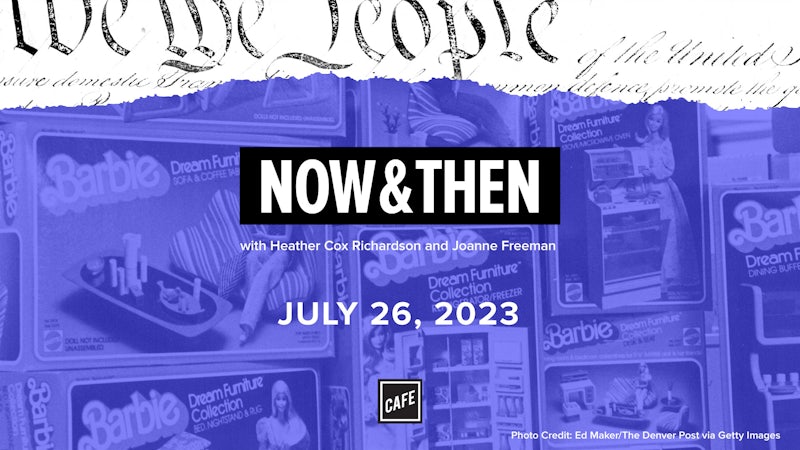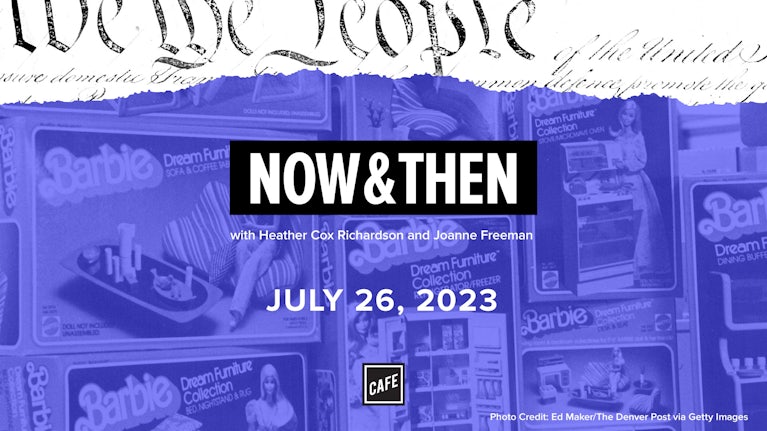Heather Cox Richardson:
From Cafe and the Vox Media Podcast Network, this is now and then. I’m Heather Cox Richardson.
Joanne Freeman:
And I’m Joanne Freeman. This week we’re going to talk about a topic that was inspired by something that happened last week, and that is President Biden made his first trip to Canada since assuming office. Americans think about Canada a lot. Canadians actually think about America a lot.
But what we’re interested in looking at is the relationship between the countries, how Americans have conceived of Canada. And how that has worked its way through American ideas about itself and the world. Now, at the end of last month, Biden went to Canada. Met with Prime Minister Justin Trudeau, largely to rebuild the relationship between Canada and the United States after four years of provocation between Donald Trump and Canada.
But in addition to relationship building, they made some specific agreements about North American aerospace defense command, about semiconductor manufacturing, about the crisis in Haiti, about climate change. And they made a high profile announcement about a deal that they struck that would allow both countries to turn away asylum seekers who crossed the border illegally. There were a lot of shows of affection between the two leaders.
It was clear that the nature of their relationship to each other and of the two countries relationship to each other was part of what they were communicating. Here’s what Trudeau said.
Justin Trudeau (archival):
Today, new threats to liberal democracy loom on the horizon. And we are united in our efforts to protect our countries and what we stand for. Canada and the US are bolstering Ukraine’s defense against Putin’s illegal and unjustifiable invasion. We are steadfast security partners through NORAD and NATO and the five eyes alliances.
We’re standing shoulder to shoulder in defense of our values and against authoritarianism. And we are working to fight climate change and create new opportunities for people in both of our countries. We are facing the future head on, eyes open, and with an unwavering belief that justice will always rise up and make as one of your favorite poets Shamus Heaney said hope and history rhyme.
Joanne Freeman:
I particularly liked that Biden is trying so hard to create alliances around the globe today. And he said back to Trudeau
Joe Biden (archival):
We’re more than neighbors. And I mean this from the bottom of my heart. We’re more than neighbors, we’re more than partners, we’re more than friends. And you alluded to it today, just a moment ago, Mr. Prime Minister, we’re more like family. We’re more like family. So, ladies and gentlemen, to family, to Canada and to the United States here, here.
Joanne Freeman:
Before we look a little bit at the United States and Canada, let’s just set the ground here with a few basic facts about the country of Canada. Canada is home to about 37 million people, which is slightly less than the population of California. It’s made up of 10 provinces and three territories. Central Canadian provinces, Ontario and Quebec are the most populous ones.
Ontario, which houses Toronto, is home to more than 15 million people. As far as its government goes, Canada is a parliamentary democracy. And its House of Commons, which essentially is its version of the House of Representatives, has 388 members. Each province and territory is led by a premier. The role is basically Canada’s version of a governor except in their system, the premier is both a member of the province’s legislative assembly and its executive branch leader.
Heather Cox Richardson:
One of the things I loved about this idea for an episode, Joanne, was that when I, anyway think of Canada, I have really distinct images in my mind. And I’ve never really tried to put them all together before. The period of Colonial Canada and the United States is sort of required knowledge on the part of American historians. Then the 19th century when Canada becomes its own country is another period which we’re pretty clear on.
And then there’s this sort of late 20th century image of Canada. And putting all of those things together is I thought really interesting. So, let’s start with the colonial era. One of the things that always jumps out to me when you do colonial American history is that there weren’t just 13 colonies on the North American continent.
And they weren’t just settled by English people. And there were lots of options for them to work with other colonies in ways that in the end they didn’t.
Joanne Freeman:
I think because we have such an American centric focus on particularly these early years, we forget that there were not only 13 North American colonies, there were Canadian colonies. There were ultimately what become the United States North American colonies, and then even the colonies in the Caribbean. All of them were linked together, at least in the mind of various empires in the world as vital places to potentially have some hand in, to have some power over.
Heather Cox Richardson:
I always think about the European empires in this period as being maritime based. And so, what they’re really interested in is harbors. And if you think about things that way, there’s really a continuity from the Caribbean up through the, what become the 13 United States colonies into Canada.
And there’s no obvious reason from the beginning that somebody would say, oh yeah, these 13 colonies are their own thing. But the Caribbean colonies and the Canadian colonies are going to be something different. So, can you walk us through that?
Joanne Freeman:
So, during the Revolutionary War, British Canada was primarily made of three colonies. Nova Scotia, including St. John’s, and now Prince Edward Island, Quebec and Newfoundland. Now, Newfoundland had been a British colony since 1610. The other colonies had been French possessions until the 1700. Mainland Nova Scotia came under British control after the 17th, 13th treaty of Utrecht.
While Quebec and St. John followed in 1763 following the French and Indian War. So, one big point about Canada and also about just generally the continent of North America is particularly England, France, and the United States jostling around. Of course initially, not the United States. Trying to draw boundaries and claim rivers and move peoples. And that’s some of what we’re seeing here.
Heather Cox Richardson:
So, tell me about how we get Acadians? Because this is the part that I think is so cool.
Joanne Freeman:
So, in the two decades leading up to the French and Indian War, England and France are maneuvering all the time in North America. England engaged in several maneuvers that were designed to secure the cooperation of the former French colonies. So, for example, in Nova Scotia, the British deported between 6,000 and 10,000 Acadians, which were French-speaking residents. Actually that happens during the French and Indian War from 1755 to 1764.
The deportees constituted three quarters of the Acadians in the area. And for logical reasons, it came to be known as Le Grand Dérangement or the great disturbance. And a lot of these Acadians eventually resettled in Spanish held Louisiana, where they essentially became the progenitors of the Cajun ethnicity. Cajuns, derived from the French word Cadien, were looked down upon by Spanish and later American leaders and remain largely separated from the mainstream.
So, they actually are an entity in and of themselves in North America after they’re displaced and moved by the British. They have their own dialect of French. They have their own distinctive cuisine, including for example, gumbo. They also have their own very fiddle heavy musical style, which I will bet many of you have in your ears now that I’ve said that.
And the Cajuns interacted closely with Creole populations, Louisiana born French and Spanish descendants. And also, the descendants of free black Americans and descendants of enslaved people. So, obviously the interaction between all these peoples is complex and deep, profound the ways in which they’re exchanging a variety of different things including culture. So, Canada ends up playing a role in certainly the mindset of American colonists during the revolution in two different ways.
So, first, the British passed the Quebec Act of 1774. And they’re trying to appease French Canadians, almost all of whom were Catholic. And the Quebec Act, among other things, said that it was going to remove references to Protestantism from government oaths and guarantee the free exercise of the religion of the Church of Rome. It was going to triple the size of Quebec.
And it was going to restructure the civil government of Quebec to grant the British crown more direct control over the legislative makeup of Quebec. Now, there were aspects of that that did not make American colonists very happy. One was the last one, which logically enough would bother people. Which is restructuring the civil government in Quebec to give the British crown more direct control over the legislative makeup of Quebec.
Americans were always sensitive about that for logical reasons, worried about that, watching about that, talking about that. It actually has a place in the Declaration of Independence. Which says, for abolishing the free system of English laws in a neighboring province, establishing therein an arbitrary government and enlarging its boundary. So, as to render it at once an example and fit instrument for introducing the same absolute rule into these colonies.
They’re worried the Americans really are not happy about Catholicism. This is not true in every single colony. But Americans considered it a religion that had a foreign king of sorts. There were colonies. The colony of Maryland was Catholic friendly, but that was an issue in the colony. So, for more than one reason, Britain made the issue of Canada and particularly Quebec, a major issue in the revolution.
Here’s the continental Congress talking about the fact that Catholicism now is essentially being deemed okay. There’s an address to the people of Great Britain at the Continental Congress sent out in 1774. And it says that they cannot, “Suppress our astonishment that a British parliament should ever consent to establish in that country a religion that has deluged your island in blood and dispersed impiety, bigotry, persecution, murder, and rebellion through every part of the world.”
They’re not fans. I will make a grand understatement. Americans are deeply conflicted about Canada. But one thing that they’re consistent in is somehow or other assuming Canada wants to be us. And that starts right here in the revolutionary period when there’s an assumption. Regardless of what they said about how scary Catholicism is, they assume that Canada in one way or another is going to want to join the other rebelling North American colonies in fighting against Great Britain.
And as a matter of fact, in 1775, so really early on in the revolution, George Washington sent Benedict Arnold, who at this point is a great hero with 1,100 men towards Quebec City armed with a letter from Washington praising the Canadians and asking them to join the American cause and Washington rights. The British have persuaded themselves. They have even dared to say that the Canadians were not capable of distinguishing between the blessings of liberty and the wretchedness of slavery.
That gratifying the vanity of a little circle of nobility would blind the eyes of the people of Canada. By such artifices, they hoped to bend you to their views, but they have been deceived. Instead of finding in you that poverty of soul and baseness of spirit, they see with a chagrin equal to our joy. That you are enlightened, generous and virtuous.
So, the assumption on the part of the Americans is, “Hey, you can come join us. You can fight with us.” I guess that’s the most important part. You can join us to fight against Britain. You’re colonies, we’re colonies, this’ll be a really useful thing. And they’re treating you badly just like they’re treating us badly.
Heather Cox Richardson:
What about the whole Catholic thing though?
Joanne Freeman:
The catholic thing lingers on. There are pamphlets written about the Quebec Act along those lines. So, it doesn’t vanish. But now we’re in a moment of war and Americans are saying, “Why can’t you join us to fight?”
Heather Cox Richardson:
The Canadian colonies say, “Excellent, we’d love to be part of you.” Right?
Joanne Freeman:
It’s a hetaerism and everything was hunky-dory from then on. No, indeed that’s not the way things go. Washington does send these troops along with Benedict Arnold and General Richard Montgomery up to Canada to kind of just take things over, seize Canada, free them. And make them free like the rest of the North American colonies.
When I teach this, what I jokingly say both throughout part of my American Revolution course and in the beginning of my early National America course is free Canada, free Canada. Which is the underlying message of a lot of what’s going on here. So, there is ultimately fighting in Canada. And actually general Richard Montgomery sent by Washington is ultimately killed.
One thing that results from this, oddly enough, is Aaron Burr becomes a hero. Apparently he’s a small man and Richard Montgomery is a large man. Aaron Burr pulls Montgomery’s body from the field when he’s shot and becomes this grand war hero and is lauded for that forever after. So, we have Canada to thank in some ways for Aaron Burr. He has a big moment in Canada.
At any rate, Canada has not obviously become part of the United States. And as a matter of fact, a large number of British loyalists, potentially some 50,000 British loyalists flee to Canada. And not only that, but a good number of formerly enslaved and free black Americans who sided with the British also rather than heading south head North. And ultimately make their way to Canada as well.
Heather Cox Richardson:
Which makes complete sense that really the 13 colonies are such a mess. And there’s certainly such a mess under the articles of Confederation that if you are the British government or loyalists hoping to retake control of the colonies, what do you do? You pull back to the west and you pull back to Canada. And you wait for the country to tear itself apart. And it certainly looks like it’s going to in the early years.
Joanne Freeman:
Sure, for a number of ways. It’s not as though this revolutionary moment with Canada somehow convinces Americans that maybe Canada does not want to be “freed” during the war of 1812. Again, fighting the British Americans. It is no surprise as to what it is that Americans once again think. They basically think we can free Canada.
We can go march up there and they’re going to want to join us and everything is going to be wonderful. So, for example, Thomas Jefferson in 1812. It’s a mere matter of marching to get Canada. It’s all we got to do. We just have to march. They want to be with us.
Who in their right mind would want to stay part of the British Empire? Obviously this does not happen either. But this ongoing American assumption that the Canadians want to be freed and want to be no longer enslaved to Great Britain, but instead want to be part of the United States, to me is always fascinating.
Because it’s so long live. It goes on forever. And it really says something more than about how the Americans think of Canada, how the Americans think about themselves.
Heather Cox Richardson:
Yes, and that is a terrific transition to the 19th century. I love this fact here. When the United States fights a war with Canada, the state of Maine actually went to war with Canada between 1838 and 1839. And of course they’re not at war with Canada, they’re war with at the time the United Kingdom because Canada’s still very much a part of that.
But after the war of 1812, when the British had pushed into what is now the northern point of Maine, and after that treaty that ended the war of 1812, it was really not clear where the boundary was between Maine and Canada. And tempers ran very hot over that border. And very briefly in 1838 and 1839 Maine masked troops, I mean I think there was about 1,000 people, on the border to go to war to establish a boundary.
And when in fact England and the United States negotiators, it was actually Daniel Webster, put together the final boundary between Maine and Canada in the Webster Ash Burton Treaty. The Mainers were furious. They really thought they had been sold out. Because the boundary was much further north than they wanted it to be. They wanted it to go all the way up almost to the St. Lawrence River.
So, that sense of the government has sold us out. And if you think about when the Webster Ash Burton Treaty happened, which was in 1842. And then you think about the other major issue with boundaries between the United States and Canada, which is the boundary that cuts across the northwestern part of the United States. Which is the boundary that’s negotiated in 1846 under the Polk administration.
Polk got elected on the concept that we were going to go all the way to 54/40 or fight. That’s what that’s about. He was going to go to 54/40 and fight against Canada and he was going to take Mexico. And as soon as he gets in office, he establishes the boundary between the United States and Canada on the 49th parallel, nowhere near 54/40 or fight.
And then turns around and says, “Oh yeah, but let’s go to war for Mexico.” And Northerners, especially people on that tier of Maine and the New England states, are like, “Wait a minute. What is going on here with this federal government that keeps promising they’re going to give us more land up here and then selling us out so they can go give more land to the Southerners?”
So, that stress between the United States and Canada pushes through into the 19th century. During the Civil War, confederates sometimes go up into Canada and have come down from Canada into the United States, into Vermont. For, example, St. Alban’s, Vermont has a very famous raid by the Confederates. But people in the United States get really angry at Canada.
Because they believe that the British government in Canada, which is sympathetic to the Confederates, is arming indigenous Americans, especially those in Minnesota to fight against the United States at a very time when the existence of the United States is under huge pressure. So, in the middle of the 19th century then, there was a sense among a number of leading politicians that eventually the entire North American continent is going to come under the purview of the United States.
And one of the key figures of that is William Henry Seward. Seward, when there was first the question of the line between Oregon and the United States, he said, “Let the Oregon question be settled when it may. It will nevertheless come back again. Our population is destined to roll its restless wave to the icy barriers of the north and to encounter Oriental civilization on the shores of the Pacific.”
Joanne Freeman:
It’s all ours.
Heather Cox Richardson:
It’s all ours. And what’s key about that is it’s not just Canada, he’s also looking to Asia as well.
Joanne Freeman:
So, when Abraham Lincoln becomes president in 1861, he makes Seward Secretary of State. And Seward serves in that role through the end of President Andrew Johnson’s tenure in 1869. And while he’s in that role, not surprisingly much in line with the United States generally in this period, he pushes an expansionist view, expansionist policies regarding Canada.
And he first tries to negotiate with the British to annex British Columbia. Which at the time was in financial trouble, had government instability and I suppose seemed likely to fall in line.
Heather Cox Richardson:
And has spectacular ports. I mean, we’re back to the ports here.
Joanne Freeman:
Back to the ports.
Heather Cox Richardson:
And Asia. So, Seward actually goes so far as to argue that the British should give up the ports essentially. But to give up significant land in the west of Canada as some sort of reparations for the Alabama claims. The Alabama claims were the settlement of claims that the United States made against England after it had let confederates use British shipyards in order to create worships that were really damaging during the Civil War.
Especially along the Atlantic coast and especially to Maine. And while they’re trying to push that argument, Russian minister to Washington in February of 1867 told Seward that the United States could buy Alaska if they wanted it. And Seward moves to buy Alaska really quickly. The Senate approves that sale for $7.2 million in April of 1867.
Joanne Freeman:
So, now just as Seward is signing the Alaska Treaty, England’s Queen Victoria is agreeing to the union of four Eastern Canadian provinces. And the confederation system incorporates the provinces into a parliamentary government that would collaborate with, and I suppose still ultimately answer to England.
Which would allow for unified policies and a more unified culture. And not surprisingly, this new Canadian confederation leads to a swell of nationalism among Canadians across the dominion. So, for example, Alexander Gat, who is one of the fathers of the proposal and the confederation first Minister of Finance says rather aggressively, “If the United States desires to out flank us on the West, we must lay our hands on British Columbia and the Pacific Ocean.”
“The country cannot be surrounded by the United States.” So, in the end, rather than staying with Seward’s vision, the Canadian Confederation grows in coming years to incorporate Western Canadian provinces with British Columbia joining in 1871. So, it comes out of this with a new stronger sense of itself.
Heather Cox Richardson:
But then, all of a sudden Canada becomes a cool place for draft dodgers. And this is one of the things that I think is so interesting is how we got to that place and in a sense, the cultural meaning of Canada for the United States instead of simply the political meaning. The self-definition against each other changes really, really dramatically in the 20th century. And that story itself is I think a really interesting one.
Joanne Freeman:
This brings us to Pierre Trudeau, who is born to French Catholics in Montreal in 1919. His father was a wealthy real estate investor. And he attends Université de Montréal Law School, goes to Harvard’s Grad School of Public Administration. In 1949 he backed minors during a strike in, it’s actually asbestos Quebec, which gave me pause when I first read that.
But it is indeed asbestos Quebec. He wrote a book decrying the anti-labor actions of the Canadian government. And continued to write liberal political writings throughout the ‘1950s in a journal that he co-founded Cité Libre. And becomes an influential law professor at his Montreal alma mater. Now he’s elected to parliament in 1965 in Prime Minister Lester Pearson’s administration.
And two years later, Pearson made Trudeau the nation’s Minister of Justice, which is roughly equivalent to the American Attorney General. And while in that position, sort of along the lines of what he’s already been doing, he pushes sweeping reforms. He legalizes lotteries. He offers some access to abortion. He eases divorce stipulations and gives legal recognition to gay Canadians.
Heather Cox Richardson:
So, in April of 1968, Pearson resigns and Trudeau wins an election to replace him as prime minister. Now, look at the timing. April 1968, you think about what America’s going through in ’68. It starts in January with the Tet Offensive. It goes into the assassination of Martin Luther King Jr. In April of ’68. And soon we’re going to have the assassination of Robert Kennedy.
And then after the assassination of Kennedy, we’re going to have the election of Richard Nixon. So, in ’68 Americans are looking at the reassertion of a really sort of Nixon’s law and Order campaign. His desire to reestablish that they’re not going to be like those crazy people out in California, really straight laced, if you will. The reassertion of what in 1970, the Time Magazine is going to call Middle Americans.
And they define middle Americans essentially as Goldwater rights, who don’t like any of the revolutions of the 1960s. Don’t like any of these things or want to move back really to the ‘1950s. And at the same time, Canada, elects Trudeau.
Joanne Freeman:
Now Trudeau, he presents a strong image when he’s prime minister. He’s a bachelor when he takes office and he makes some waves with his love life. He dates Barbara Streisand, who apparently had recently separated from actor Elliot Gould. And this happens in the early months of his tenure as Prime Minister.
Then in March of 1971, the 51-year-old Trudeau married 22-year-old Vancouverite Margaret Sinclair. She’s the daughter of a powerful politician, but she becomes a global celebrity in her own right. And she parties at Studio 54. She hangs out with the Rolling Stones. She supposedly had affairs with a number of famous Hollywood celebrities and political folk.
Now it’s not as though when he’s Prime Minister, all he’s doing is dating and fueling Trudeau mania. There actually are pretty significant political issues happening during his tenure. For example, there’s a separatist movement which reaches its zenith while Trudeau is in office in October of 1970. This is a group that wants Quebec Quoi independent.
And ultimately this group, the FLQ, the Front de Libération du Québec, kidnapped two high ranking British Canadian officials, kills one. And Trudeau has to initiate a crackdown ultimately to stop them. So, although he may be glamorous initially bachelor and then newly married man, there are important political things happening during his tenure.
Heather Cox Richardson:
So, again, this is really interesting. I do remember it because of course it was a big deal in Maine what was going to happen with the Quebecois. But most Americans in fact, were paying attention to Trudeau and Canada in this era for a different reason than that. And that is that Trudeau is also overseeing the arrival of about 100,000 American draft resistors who fled to Canada to avoid serving in the Vietnam War.
So, the contrast for that generation between what was happening in America in the ‘1960s and ‘1970s and what was happening in Canada, I think really changed the way Americans thought about Canada. So, on March 25th of 1969, Trudeau visited Nixon in the White House. And he spoke at the Washington Press Club and made a number of controversial comments, including supporting the draft evaders who had fled to Canada and had enrolled in universities in Canada. He said.
Pierre Trudeau (archival):
Their presence has been felt. They have aroused a great deal of sympathy on the Canadian campuses. By and large, they have proved to be good students, quarterly students. And much of their attitude, I believe, is dictated by reasons of conscience rather than by any desire to upset a particular order of things.
Heather Cox Richardson:
It’s a real slap directly at Nixon’s characterization of them as being troublemakers and being people who were deliberately trying to undermine society.
Joanne Freeman:
He also made a statement really drawing a line between what the United States was and what Canada was at this moment in a different way. He said.
Pierre Trudeau (archival):
Living next to you is in some ways like sleeping with an elephant. No matter how friendly or even tempered is the beast, if I can call it that, one is affected by every twitch and grunt.
Heather Cox Richardson:
Not surprisingly, the relationship between Nixon and Trudeau became decidedly strained as Trudeau fiercely opposed the Vietnam War and even considered pushing Canada to leave the North Atlantic Treaty organization that is NATO. He issued a scathing denunciation of the December 1972 Christmas bombings in Vietnam. Which was designed to push the North Vietnamese back to the negotiating table. And that killed more than 1,600 civilians.
Nixon and Trudeau also fought as Nixon became increasingly protectionist over trade. So, in a White House visit in 1971, Trudeau extended his elephant remarks and urged Nixon to bring Canada into any economic decision making. The conversation was not known until it was released in 2008.
But Trudeau said to Nixon, “If you’re going to be protectionist, let’s be in it together. I’m not a nationalist. I’m not a protectionist. If you’re going to take a very protectionist trend, our whole economy is so importantly tied to yours, we’d have to make some very fundamental decisions.”
Joanne Freeman:
After Trudeau’s departure, Nixon called him “a pompous egghead” and “a clever son of a.” That’s just very Nixon sounding. Before ordering his chief of staff, HR Haldeman to plant a critical story about Trudeau in a syndicated column. One more note on the Nixon Trudeau relationship. Nixon visited Ottawa in April of 1972 in the middle of what was a rather icy moment between Nixon and Trudeau.
And at a gala at the National Arts Center, Nixon offered a kind of surreal moment in just an offhand comment that he made referring to Trudeau’s four-month-old son, Justin at the time. Nixon said, tonight, “We’ll dispense with the formalities. I’d like to toast the future Prime Minister of Canada, Justin Pierre Trudeau.” And there you go.
Heather Cox Richardson:
Trudeau served for almost 16 years before he retired in 1984. And notably in 1982, he’s the person who accomplished the formal end of British control over Canada known as the Constitution Act for Canada. Which gave Canadians broad-based control over their own domestic rights and foreign policy.
But what really interests me about that moment is, as you say, Joanne, the degree to which Americans define themselves against Canada. And in this case define Canada as what many Americans wish America could have been in that moment.
And that idea of Canada as an welcoming, tolerant, liberal democracy at a time when the opposite was happening in America, I think first of all, created an image for a lot of Americans about what Canada is. But it also got imported to the United States with music.
Joanne Freeman:
I would be curious what you have to say about this, Heather. So, on the one hand, absolutely that this Canadian view of itself, and I suppose also of the United States is being beamed into the United States through music. But I kind of wonder how the United States received and interpreted that kind of message.
And I mentioned that only because Canadian author Margaret Atwood once referred to the US Canadian border as “the longest one-way mirror in the world.” Meaning that Canadians look through the mirror and see the United States. And that the United States looks at that mirror and only sees itself. But I’m curious as to what we’re going to say we feel as we talk here about this important way in which Canada sort of imported itself into the United States.
Heather Cox Richardson:
What I was referring to is something like the guess who’s American woman from 1970. Which is again, the vision of a certain part of the United States Society, it’s a critique of America. And for I think in this era, a lot of Americans who were disappointed with the direction that the United States was taking under Richard Nixon looked to Canada and thought, “Oh, that’s paradise up there.” It really was not necessarily about what Canada really was so much of what Americans wanted America to be.
Joanne Freeman:
So, that actually does fall in line with the one way mirror. Americans in one way or another, whether it’s something they like, well, in this case because it’s something they like and that they would like America to be. They essentially are seeing themselves in looking at Canada
Heather Cox Richardson:
And really dramatically the guess who’s American woman in 1970, at the same time that Time Magazine is talking about how the people of the year, the middle Americans who are essentially Goldwater rights, the guess who is arriving and saying…
Joanne Freeman:
You got to let me do this.
Heather Cox Richardson:
Go ahead.
Joanne Freeman:
You got to let me do this because this is such a good song. When we were talking about this and preparing for the episode, that’s got to be the case that some of you out there having the same experience. What went into my head was American woman. American woman, so you’d get away.
‘American woman, listen what I say. Don’t come a-hanging around my door. Don’t want to see your face no more. I don’t need your more machines. I don’t need your ghetto scenes.’ That’s a really powerful rock song. Which interestingly, some members of the band said it wasn’t intended to be political. But other members of the band said it most certainly was intended.
Heather Cox Richardson:
Come on, Randy Bachman said it was entirely about politics. I mean, it was certainly understood that way when it came out. Randy Bachman was the guitarist of Guess Who, and later of course founded Bachman-Turner overdrive. And he said this was about looking at America in this particular period.
And when Tricia Nixon invited the guess who to play at one of her White House parties in July of 1970, the Nixon staff expressly forbade them to play American Woman. So, I’m guessing it really wasn’t about how nice Canadian girls were.
All right, whatever reason the group wrote the song, it is certainly the way it was taken. In fact, when we were looking at the prep for this episode, and I saw somebody tried to say it was about how nice Canadian women were, I was like, “Really?” Because I was like eight in 1970, and even I listened to that song and I’m like, “Oh, wow.”
Joanne Freeman:
Wow, they’re saying something.
Heather Cox Richardson:
I know exactly what’s going on here.
Joanne Freeman:
I have to just throw one last factoid about this song only because if we’re talking about the reflection and implication of the United States and Canada through music, guess what happens to the song American Women in 2015? It’s being used to sell Nike sneakers. So, America ultimately takes it and says, “Well, that’s a great song. I don’t really care about what it says. It’s about American women.”
Heather Cox Richardson:
And now I’m speechless. But of course, Neil Young was a Canadian as well who had a great amount of effect on American politics through his many songs about Canada. He came originally from Ontario and spoke a lot about what Canada meant and sort of the dream of Canada.
Neil Young (archival):
There is a town in North Ontario. With dream, comfort, memory to spare. And in my mind, I still need a place to go. All my changes were there.
Heather Cox Richardson:
But of course, they were also powerful voices with songs like Ohio for Dead in Ohio about the shooting at Kent State in May of 1970. So, that moment in the 1960s in Trudeau and the 1970s and what that came to mean to America through people like Neil Young. And through people like Joni Mitchell, who also is Canadian and is creating a critique of American society as well as the image of Canada as sort of a paradise
Joni Mitchell (archival):
On the back of a cartoon / In the blue TV screen light / I drew a map of Canada / Oh, Canada / With your face sketched on it twice
Heather Cox Richardson:
Or Gordon Lightfoot as well.
Joanne Freeman:
Nostalgic.
Heather Cox Richardson:
Yeah.
Joanne Freeman:
But also sort of sun lit, what we’re not.
Heather Cox Richardson:
And I have to say in terms of Gordon Lightfoot, I had a fascinating experience recently where Paterson Hood of the drive-by Truckers said that Gordon Lightfoot record wreck of the Edmunds Fitzgerald was one of his absolute favorite songs and had really shaped the way he thought about music.
Gordon Lightfoot (archival):
At 7:00 PM a main hatchway caved in. He said, “Fellas, it’s been good to know ya.” The captain wired in, he had water comin’ in. And the good ship and crew was in peril. And later that night when his lights went out of sight. Came the wreck of the Edmund Fitzgerald.
Heather Cox Richardson:
And I would not in my wildest dreams have put the Canadian balladeer Gordon Lightfoot in the same sentence as one of the front men for the sort of southern rock band, the Drive-by Truckers.
Joanne Freeman:
That’s such a song.
Heather Cox Richardson:
And yet that’s when he grew up. So, that’s what you heard. You heard these Canadian singers on the radio in the early ’70s. And they had a huge effect on the way people thought about the United States and also about Canada. So, in a way, this brings us back to the place we started.
In that in 1975, the band, which is originally formed in Ontario in 1967, recorded an album called Northern Lights Southern Cross. And on that album they had Acadian Driftwood. And Acadian Driftwood is first of all, one of our producer’s favorite songs. Shout out to you here, David. And in the song, Levon Helm, who’s the drummer. And the pianist, Richard Manuel and also the bassist, Rick Danko, all take turns singing the melody. And the lyrics actually were inspired by a poem that Henry Wadsworth Longfellow wrote in 1847 about the Acadians, about the people who were forced out of Nova Scotia into what is now Louisiana. Henry Wadsworth Longfellow writes this poem in 1847, Evangeline, which details how young Evangeline is looking for her lost lover Gabriel during the great displacement from Nova Scotia into what is now Louisiana.
And it evokes this paradise. It evokes this lost paradise. Longfellow writes, “He who believes in affection that hopes and endures and is patient. Ye, who believe in the beauty and strength of women’s devotion.” List to the mournful tradition still sung by the pines of the forest. List to a Tale of Love and Acadi home of the happy. And in 1975 in Acadian Driftwood, the band picked that song up.
Joanne Freeman:
Something that strikes me now particularly about this music and we’re hearing all of these lyrics from Canadians or Americans who were at one point Canadians. We started out talking about the need to recharge or repair the relationship between the United States and Canada. And we talked about all of the policy issues accompanied by President Biden’s trip to Canada.
But based on everything we’ve said here today, in addition to the very real politic diplomatic political policy reasons why the two countries need to be in line, or at least in conversation with each other. The fact that their neighbors, family and friends so close to each other and often entangled and not necessarily in line angry at one another in some ways. Particularly Canada asserting itself as not necessarily being the United States.
It’s all a reminder about the ways in which the Canadian American relationship is really important. And Americans probably don’t think about it very much because of that one way mirror. They see themselves when they look to Canada and they shouldn’t.












